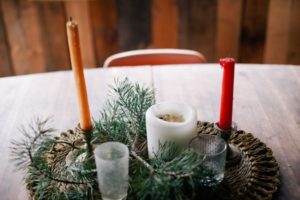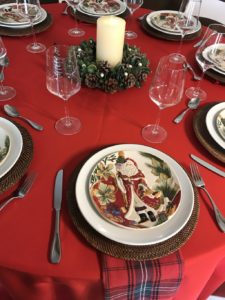Three Rules Of Three For Creating A Beautiful Christmas Tablescape
Family and friends arrive in a few short hours. The Christmas tree is decorated with white twinkling lights and baubles of green, red, and gold. Garlands of evergreen are draped across the mantle. A delicious ham is baking in the oven. Bottles of wine are chilling in the fridge. A warm Texas pecan pie sits on the cake plate. Everything is in place for a wonder-filled Christmas dinner.
Besides Thanksgiving dinner, Christmas dinner is perhaps the most significant meal of the entire year, and it is the dining room tablescape that sets the tone for such a momentous feast. For this reason, careful planning and consideration should go into creating it.
A tablescape refers to the arrangement of basic pieces on a table, creating an overall look or mood. A traditional tablescape is composed of elemental items, including linens (such as a tableclothes, a table runner, and napkins), charger plates, dishware, silverware, stemware, centerpiece(s) and/or candlesticks.
Creating a beautiful Christmas tablescape, however, is more than just the culmination of linens, place settings, and a centerpiece. In addition to being aesthetically pleasing, a tablescape should reflect a general feeling or temperament when the pieces are combined.
One way to make this happen is to choose three words to describe your perfect Christmas tablescape, and carefully select items which embody those three words.
These words should reflect your personal style or the mood you wish to evoke. For example, whimsical, modern, and simple or traditional, elegant, and brilliant.
Likewise, it is important to consider the three principles of height and scale, color, and texture to create a truly magnificent Christmas tablescape.
Height & Scale
Height generally refers to how high or low the pieces of your tablescape are. As the hostess, your style, the occasion, and the mood you’d like to create should influence your choice of height. Tall centerpieces tend to close spaces while shorter ones tend to open them up. Tall centerpieces tend to be more elegant; however, they can also be harder to create. Tall centerpieces can create talking points for family and friends who might struggle with conversation. Short centerpieces allow for better conversation over dinner. Generally, tall pieces measure around 2 feet or higher while short pieces measure around a foot or shorter. Varieties of height add texture, so consider mixing tall pieces and low pieces for added fullness and volume.
The shape and size of the table also determines the scale of the design. Round tables are best suited for single centerpieces and taller centerpieces. Because it has more space in the middle, square tables require a single, fuller centerpiece. A single centerpiece, however, might make a rectangular table appear sparse. Rectangular tables are best suited for multiple centerpieces along the middle of the table, tapering off as they reach the ends of the table.
Color
Color choices or color schemes will help to set the tone and add to the ambiance of your event. It will also add texture to your design. When choosing a combination, choose colors you like to look at, colors that are pleasing to your eyes and make you feel good. Make sure the colors you choose harmonize with the interior color scheme of your home and evoke emotions you want your guests to feel.
Here are some traditional and uncommon color combinations to consider this holiday season:
- Elegant all white
- Nontraditional black and white
- Traditional reds, greens, and golds
- Warm reds, yellows, and golds for a cozy feel
- Cool blues, icy whites, and silver for wintry snow
- Autumnal tones of beige, brown, yellow, and rust
- Red combinations like red and white, silver, or gold
- Frosted hues like light blues, white, ivory, and brushed gold
- Neutrals like forest green, light greens, white, brown, and gold
- Jewel-tones like navy blue, hunter green, deep red, bright purple
- Shiny metallics such as silver, gold, iron, brass, pewter, and bronze
- Rustic hues like cranberry red, hunter green, sage green, and white
- Pastels such as ink, peach, butter yellow, baby blue, lilac, and mint green
Texture
Using various textures for your tablescape add volume to it. As a general rule, it is best to choose only three textures so as not to overwhelm the design. For example, you might select combinations of metal, glass, and wood or fabric, shine, and paper.
Texture can be added to almost any element of a tablescape. A simple way to add it is by layering your basics. Begin with a base layer such as the tablecloth, table runner, or charger plates. Charger plates come in a variety of tones and textures like glittering, mirrored, wooden, rattan, or cotton surfaces. Build onto the base layer by adding dinner, salad, or even dessert plates. For additional texture, think about using different materials types for your place settings, including stone, glass, and/or ceramics.
Flowers are another great way to add texture to your table. Make sure to choose flowers that are in season and that have a variety of characteristics such as flat leaves or big blooms. Christmas staples like poinsettias, mistletoe, and holly work well. Roses, cosmos, and amaryllis may also add depth and fullness to the table.
In addition to flowers, other natural elements such as berries (cranberries), fruits, and foliage add texture. Shop your backyard for natural elements such as wooden branches, pine cones, acorns, leaves, feathers, or grass. Add some sparkle to your branches by adding glitter gold spray or white, frosty layers using Epsom salt.
When adding texture, choose a variety of fabrics such as burlap, plaid, or fur. Combine smooth and rough surfaces to add dimension or consider using gift wrap as a table runner to create the illusion of fabric. Selecting non-traditional fabrics for the table add an unexpected element that will charm your guests.
You might also add texture using a variety of centerpiece elements, including light, garlands, balls, and ribbons. Ribbons in various prints and hues add color and mood and can give a unifying element to the entire look of the table. Shopping your home for centerpiece elements will ensure your Christmas tablescape is in harmony with the rest of your home. Incorporating candle light with varying levels of flames creates layers and texture. Finally, adding sweet treats such as gingerbread houses, sugar cookies, or peppermint sticks for a delightful touch.
With a little thought and creativity, you have the ability to create a beautiful Christmas tablescape to welcome your friends and family to the holiday event of the year!














